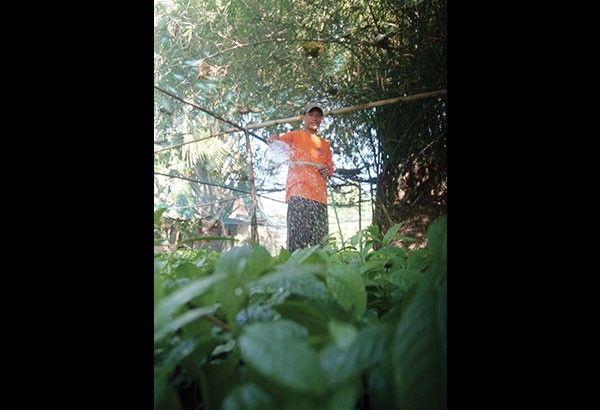Pangasinan finds ylang-ylang gold

MANGATAREM – Pangasinenses have found a gold mine in the fragrant ylang-ylang as about 200,000 seedlings of the Cananga odorata – ilang-ilang in Filipino – have been transplanted and more are being propagated in a nursery in barangay Bueno.
Since the start of propagation of ylang-ylang last July, 120 hectares of public land in Barangay Hacienda, Bugallon town; more than 100 hectares in sitio Mapita, Barangay Laoag, Aguilar town, and another 80 hectares in Barangay Bantocaling, Mangatarem have been planted to this tree by members of people’s organizations assisted by the Department of Environment and Natural Resources through its National Greening Program.
Second District Rep. Leopoldo Bataoil set up the ylang-ylang propagation project for his constituents with the help of his high school classmate and businessman Fred Reyes, one of the country’s top perfume distributors. The seeds are abundantly available in Anao, Tarlac, Bataoil said.
Reyes co-owns Philippines-based Chemworld Fragrance Factory that will buy the ylang-ylang oil products of Pangasinan for local use and export.
Reyes told Bataoil there is a big demand for ylang-ylang oil both here and abroad.
It takes five years before the plants can produce flowers with bloom cycles lasting 25 years, Bataoil said.
“It’s a sure livelihood for our people,” Bataoil said.
Bataoil said the growing of ylang-ylang would not be limited to the three towns as other towns may also plant it provided they can conform with specifications and their products would be sold to the company.
He said they would continue to plant ylang-ylang and try to sustain expansion.
Ylang-ylang is a tropical tree believed to have originated from the Philippines and is valued for its perfume. The essential oil derived from the flowers is used in aromatherapy.
Mangatarem municipal councilor Ricardo Pastor Jr., caretaker of the ylang-ylang nursery here, said about 60,720 seedlings have been planted in Bugallon, another 22,240 seedlings in Bantocaling, Mangatarem and 70,000 in Aguilar town for the first batch of transplanting.
Another 200,000 seedlings are being grown and expected for distribution in June for the second batch.
This month, about 15 kilos of ylang-ylang seeds that can produce 150,000 seedlings are expected to arrive, Pastor said.
Pastor said they have 75 percent survival rate.
“Yes, we found a gold mine in ylang-ylang,” he said.
Pastor said each ylang-ylang tree that flowers year-round can produce three kilos of flowers per week.
The flowers are harvested early morning or late afternoon when there is no sunlight.
Chemworld is set to put up a mobile facility to extract the oil and store it for pick-up.
The nursery here employs 12 workers, some of them out-of-school youths.
Pastor and his group also go school hopping, campaigning about ylang-ylang planting and distributing seedlings.
He said last Dec. 31, he talked to indigenous people about ylang-ylang and they manifested interest to plant in about 200 hectares of public land in Labrador town.
Bataoil said Reyes would buy the ylang-ylang oil produce.
He quoted Reyes as saying that “in this kind of industry, market is not a problem.”
Reyes will put up an extraction facility and buying station in Bataoil’s district to assure planters of a ready market.
Bataoil spoke in a forum with the Management Association of the Philippines last month on his ylang-ylang initiative.
He said the project addresses the need for livelihood of his constituents especially the marginalized sectors. One tree yields a harvest of three kilos of flowers per week or about P180 worth, he said.
It also works alongside climate change concerns with the National Greening Program as a major responder, he said.
The congressman also hopes to bring back the glory days of ylang-ylang production in the Philippines and to make the second district of Pangasinan the country’s major producer.
Environment Secretary Gina Lopez came to the ylang-ylang nursery here when she visited the Mangatarem hot spring last month.
“She got excited. She was so happy to learn about this,” Bataoil said.
Olivier de Bontin, writing about about ylang-ylang oil production in Madagascar and the Comoros, said, “It is generally thought that ylang-ylang originated from either the Molucca islands or the Philippines. Its name arises from the Filipino word Alang-Ilang, which expresses the lightness and mobility of the flower to the least breath of wind.”
The study said that the first cultivation of ylang-ylang for commercial distillation occurred in the 19th century in the north of Manila.
“Until the beginning of the 20th century, ylang-ylang Manila was almost the only source of the oil and it was regarded as the best and finest for a long time afterwards,” the study said.
Proper care
Every ylang-ylang given to an interested planter is accompanied by a small piece of paper containing pointers on its proper care.
The note says, “Please plant this ylang-ylang seedling in your backyard or in an open field. In five years, it will bear flowers all year round. About three kilos of flowers per tree per week can be harvested, if properly grown and well maintained. Currently, the cost per kilo is P60. Therefore, expected income is P180/tree/week.”
Care instructions were also indicated: distance between trees must be six meters; use organic fertilizer only and prune regularly so the tree will not exceed six feet.
- Latest






























